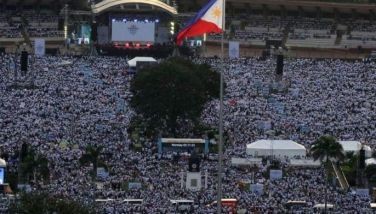NIMBY

Coming soon to a body of water near you: a modular nuclear reactor.
Or maybe not.
The use of nuclear energy is again a possibility, four decades after the post-EDSA government mothballed the Bataan Nuclear Power Plant amid earthquake safety issues and a scandal over an $80-million kickback reportedly received by Ferdinand Marcos the elder from BNPP builder Westinghouse.
Interest payments alone for the construction of the BNPP white elephant, whose cost kept ballooning like the palace senators are building for themselves in posh BGC, cost Filipinos billions.
Last Tuesday, Washington announced that a civil nuclear cooperation agreement between the Philippines and the United States came into force effective July 2.
Giving nuclear energy a better image in the eyes of Filipinos must be part of the ongoing rebranding of the Marcos name. But because of the BNPP kickback scandal, the cynical view is that some folks in Marcos 2.0 are seeing fat BNPP-type commissions from the energy projects that may be approved.
It looks like reviving the BNPP is too expensive, even for an administration that thinks the government has so much surplus assets it can afford to set up a sovereign wealth fund.
Also, Bataan residents led by the Roman political dynasty don’t want a nuclear plant operating in their midst.
Fortunately for nuclear energy proponents, modular reactors have been developed.
* * *
NIMBY – not in my backyard – will be one of the biggest hurdles for anyone thinking of forging nuclear investment deals with Marcos 2.0.
No matter how rosy the promises made by Philippine officials in so-called investment roadshows, nuclear energy players must be warned that there’s often a yawning chasm between the signing of contracts in this country and seeing a project come onstream.
The telecommunications giants can’t even install telco towers near the exclusive gated villages of Forbes Park and Dasmariñas Village in Makati where most of their bosses live, because residents fear that telco signals adversely impact health and may shorten the life of Botox treatments.
Millions of Metro Manila residents may have to wait forever for Kaliwa Dam to come onstream to provide additional potable water for the ever-growing population, because of resistance to the project by indigenous peoples and environmental groups.
Executives of energy companies have lamented the difficulty of hurdling right-of-way issues in implementing their projects, no matter how strenuously they argue that the opponents themselves stand to benefit from more reliable energy supply.
Outside urban centers, telcos and power companies also have to deal with their towers being bombed by extortionists of the New People’s Army.
We want renewable energy? These days, we’re seeing pushback from affected residents and environmentalists against the construction even of floating solar panels.
And now, floating nuclear reactors? Even if these are modular or micro, good luck on that.
* * *
Because of all the difficulties, energy players think the country needs a longer transition period to renewable energy. The government is aiming to have RE account for 35 percent of the country’s power generation mix by 2030. Nuclear power is projected to generate at least 1,200 megawatts by 2033, with another 1,200 MW by 2035 and 2,400 MW by 2050.
Aboitiz Power Corp. chief corporate services officer Carlos Aboitiz recently told The STAR that RE is more expensive than coal, and people must be prepared to pay more for electricity if they want RE.
Nuclear energy is supposed to provide cheaper electricity. But Japan, with its numerous nuclear reactors accounting for 7.5 percent of its energy mix, still had the highest electricity price in the Asia-Pacific as of September 2022, according to Statista. (Natural gas and coal accounted for over 30 percent each.)
In Southeast Asia, the Philippines and city-state Singapore, which has no significant natural resources for energy generation, have the highest power rates.
Energy players have pointed out that this is because the cost of electricity is government-subsidized in Malaysia, Thailand and Vietnam. Manufacturing powerhouse Taiwan also has subsidized electricity. There are long-standing proposals for the Philippine government to subsidize electricity costs, to attract more foreign investments and stimulate local manufacturing.
The Civil Nuclear Cooperation Agreement between the Philippines and the US, also called the 123 Agreement, signed in November last year, provides a legal framework for American exports of nuclear fuel, equipment, special materials and yes, reactors, to the Philippines.
Nuclear scientists in the Philippines point out that the country has been using nuclear technology for civilian purposes for a long time, such as in medicine.
When it comes to nuclear reactors, however, a key concern among Filipinos is safety, especially after the meltdown of the Fukushima Dai-ichi reactor in Japan following that apocalyptic earthquake and tsunami in March 2011.
The accident prompted Germany to accelerate its de-nuclearization, citing safety issues. In mid-April last year, the world’s fourth largest economy shut down its last three nuclear plants.
And here we are, moving in the opposite direction.
The 123 Agreement vows to take into account standards and safeguards set by the International Atomic Energy Agency in the peaceful uses of nuclear power. I’m sure the Dai-ichi reactor also followed the IAEA standards.
I’ve visited nuclear power plants in several nuke-technology-exporting countries, and two common issues the operators told me stand out.
One is that current nuclear reactors are designed to withstand earthquakes, but nothing greater than Magnitude 8, and certainly not a Magnitude 9 to 9.1, which was what struck Fukushima.
Another is that there is still no technology to dispose of nuclear waste so that it loses its harmful, radioactive property. What’s done is that operators seal the radioactive waste in cooling chambers, and then hope it stays sealed forever.
So who wants nuclear waste sitting near their neighborhood? Surely not the local proponents of nuclear power.
- Latest
- Trending




























